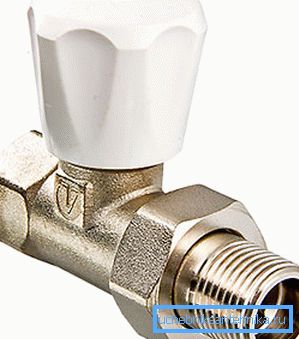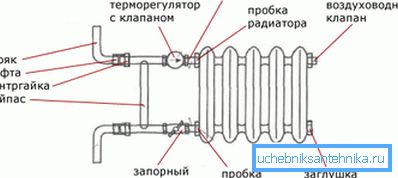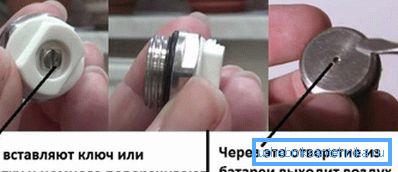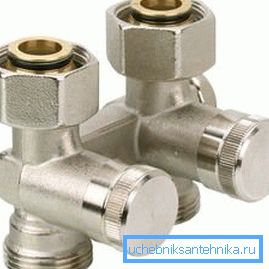Radiator valve - everything you need to know about this
When using water heating can not do without the use of valves and control valves. Thanks to the installation of different types of radiator valves, it becomes possible to adjust the heating of the battery, increasing the reliability of the heating system as a whole.
Of course, such an effect will be achieved only if the person clearly understands which tap is optimal for solving the corresponding problem.

About types of radiator cranes
All faucets for radiators can be divided into 3 groups:
- to adjust the flow of coolant to the heating device. This makes it possible to change the temperature in each individual radiator by reducing / increasing the coolant current through it. For this purpose, standard valves are usually used, and the passage of the pipe is blocked by turning the valve manually;

Note! In order not to mess around several times a day, it makes sense to use special thermal heads with automatic adjustment to adjust the temperature of the battery. After the initial calibration, they will then regulate the temperature themselves.
- in order to "turn off" the battery from the heating circuit. If the adjustment valve for radiators reduces the coolant current through the pipe gradually, then in this case it is necessary to immediately turn off the heater. For this purpose, the simplest ball valves are used, and in order for the heating system to work further - a bypass, a section of the pipeline connecting the supply and discharge pipes, is arranged.
Note! Of course, shut-off valves need to be installed beyond the bypass, i.e., closer to the battery.
- sometimes, even if all the installation rules are observed, air can accumulate in it, which leads to uneven heatingy A simple construction is used for bleeding air plugs - Mayevsky's crane. The price of this device is a cheap one (domestic manufacturers set a price tag of about 160-200 rubles), and the benefits are enormous - periodical bleeding of air allows all radiator sections to work with maximum efficiency.

As for the installation site, the shut-off and control valves can be installed on both horizontal and vertical pipe sections. Also on sale you can find the radiator corner valve - the principle of their action does not differ from the ordinary, and the whole difference lies in the form.
Read more about the device, the principle of operation and the choice of cranes for radiators
For informed choice, it is necessary to clearly understand the device and principle of operation of a particular type of adjusting / locking device, as well as to determine the purpose of the valve (shut-off or regulating). When installing radiators, you need to solve such issues as: adjusting its heating, the ability to turn off the battery during the high season, remove air plugs without turning it off from work.
Therefore, the focus is on cranes, allowing to solve these problems. In particular, ball, conventional regulating cranes and a Mayevsky crane are considered.
Valves
Ball valve can be considered the simplest representative of valves. Usually it is used not as a regulating valve for the radiator, but for the complete and fast overlapping of the coolant current through the battery - that is, to turn it off from the work of the heating circuit.
Such an application of valves requires the connection of the supply and discharge pipes with a jumper; when the valves are closed, the coolant is bypassed by the heater through this jumper. And it can be done almost instantly, it’s enough to turn the tap knob 90 ?.

The main element of such a device is a metal ball with a through hole and cut segments. In expensive models, spring-loaded gaskets are used, which fit snugly to the ball and provide tightness, in devices cheaper, tightness is achieved due to the fact that the ball is pressed against the flow of heat-transfer agent to the sealing gasket.

Three-way ball valve for radiators can be installed directly instead of the tee when organizing the bypass. During operation, it will be possible to direct the flow of water completely into the heater, completely bypassing the radiator or partially into the battery and partially through the bypass - everything depends on the design of the faucet. With this approach, the function of adjusting and shutting it down is combined.
Heating adjustment
The most cost-effective way to regulate the flow of hot water into the battery can be considered to be the installation on the supply pipe of a conventional adjustment device, as the valve rotates, the pipe gradually closes. When installing, only detachable connections are used (as a rule, socket joints), so the installation instructions include just a couple of points: wind the FUM tape on the thread and screw the tap.
Note! The simplest ball counterparts cannot be used as control valves because they have only 2 working positions — they are normally open and normally closed.
Manual adjustment is not very convenient - firstly, you have to constantly turn the crane knob, and secondly - the adjustment accuracy is not up to par. Special regulators with a thermal head are much more convenient - they will allow to forget about temperature control altogether, everything will happen in automatic mode.

The device of such thermostats is extremely simple - the main "working body" in it looks like a sealed chamber with corrugated walls. Inside it is a liquid or gas, which expands when heated. This process causes the elongation of the bellows (the same sealed chamber), due to this there is a decrease in the lumen and, accordingly, a decrease in the coolant current through the radiator.
Removing air plugs from the battery
The occurrence of an airlock can be judged by the uneven heating of the battery, some of the sections are hot, and some - barely warm. Mayevsky's crane will help to cope with this problem, and it can be installed without special restrictions, only the diameter is important.
It is also necessary to take into account the material of the battery so that the metals do not form a galvanic couple, so for the cast-iron radiators you can recommend the Mayevsky valve for cast-iron radiators of 15 mm.

As for the installation, such devices are located in the upper part of the radiator, it simply crashes into the plug at the end of the battery. And outwardly, it looks more like a regular washer.
In the center of this washer there is a hole in the form of a cone, which during operation is closed with a metal plug, which is simply screwed into the hole. In order to bleed off the excess air, just with your hands with a screwdriver turn the metal cone slightly to the left, closing the hole, you should immediately hear the hissing of the outgoing air. The process can be considered complete when water begins to flow out of the faucet.
The subtleties of choosing a crane for the radiator
When choosing, it is necessary to take into account not only the purpose, but also the installation location of the stop / control valves. So, for the supply of water to the radiator may well be used an angle tap for a radiator. Cranes for radiators with a lower connection look somewhat specific, they are a bit like binoculars.

As for the upper and lower cranes, the principle of operation and the internal structure do not differ, only the method of adjustment differs. This is the key difference - the angular upper and lower radiator valves, the upper hand adjustable, but the lower are available with adjustable turnkey. This is done so that it can be installed in cramped conditions.

Summarizing
Without cranes for the radiator can not do when installing the heating system. Thanks to these simple devices, the operation of the heating system can be regulated in a wide range, and the reliability and stability of the heating as a whole will also increase.
It is also important that the installation of such devices will not cause a significant increase in the cost of installation of heating. The video in this article describes an example of connecting a radiator using thermostats and valves.